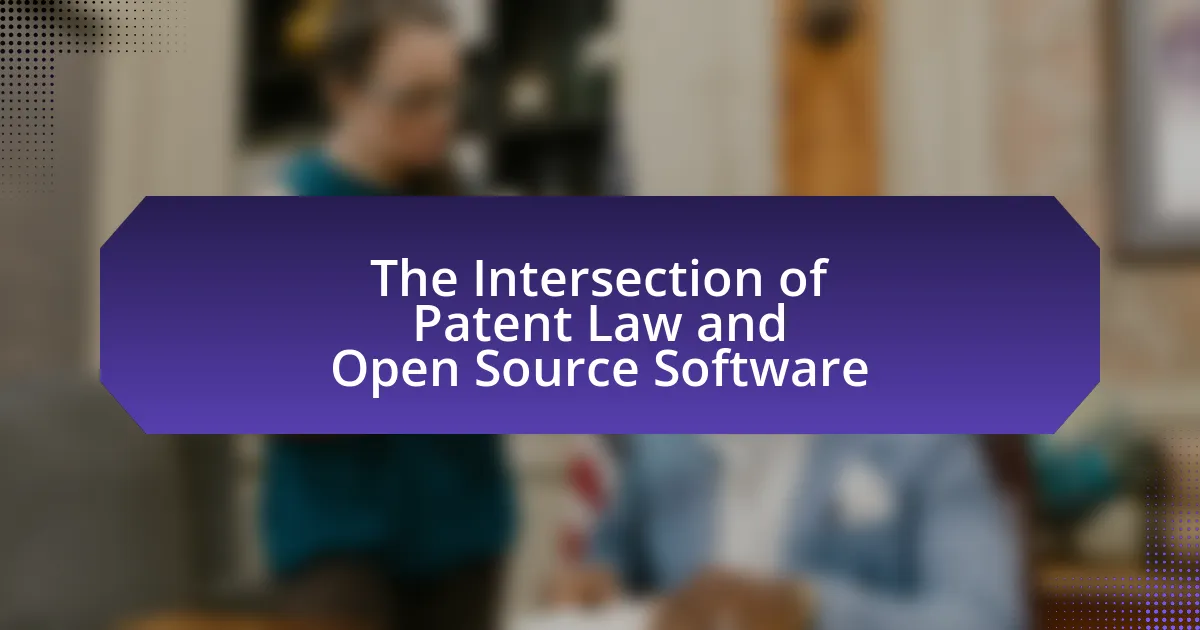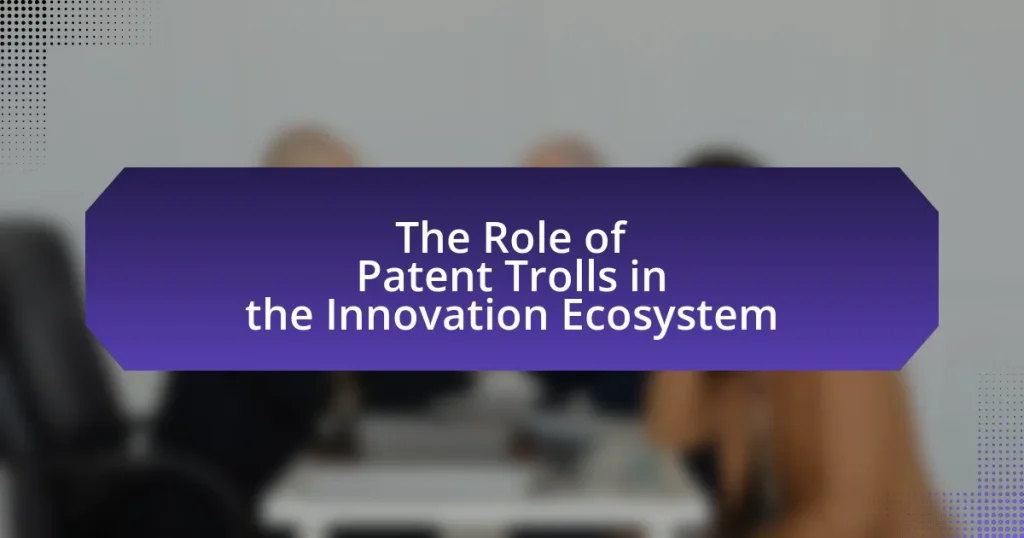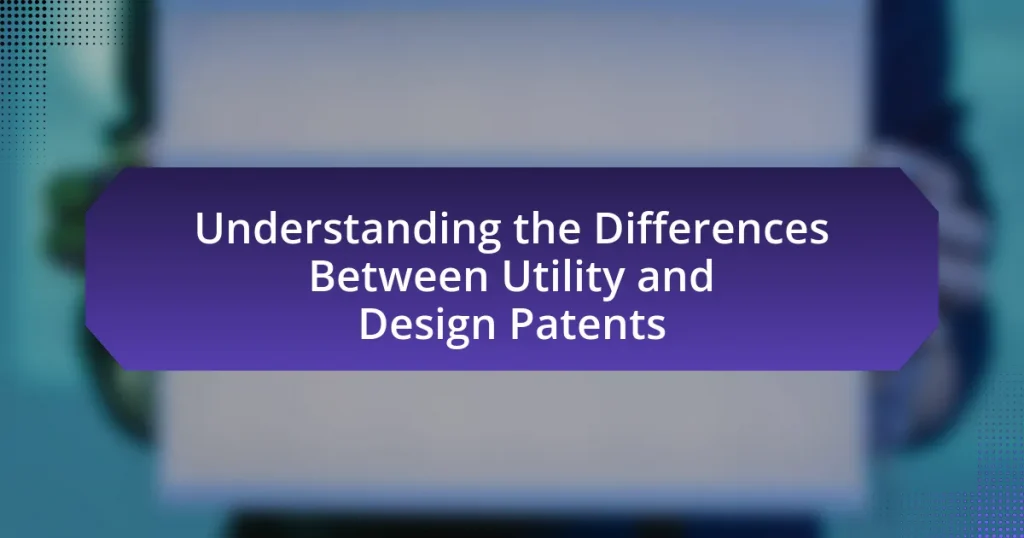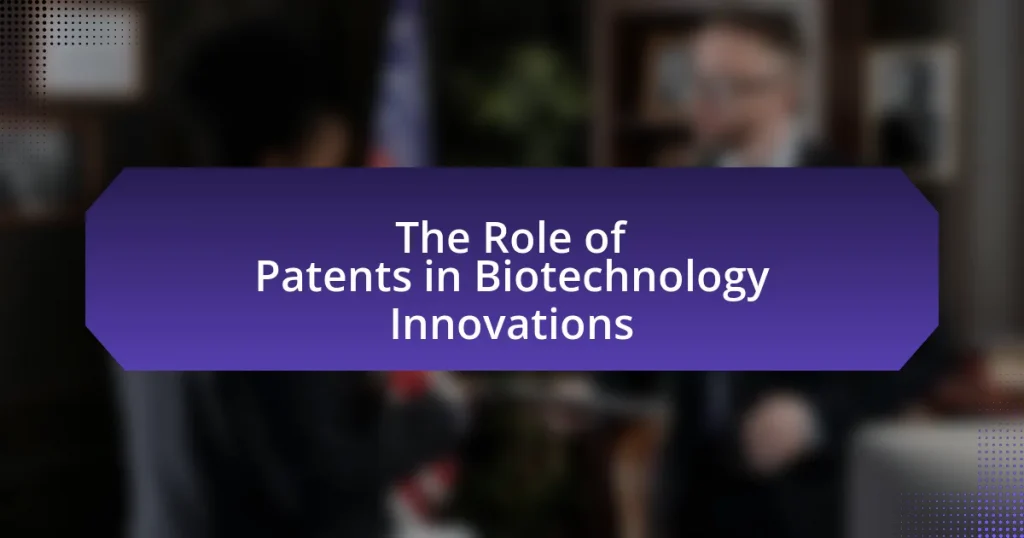The article examines the intersection of patent law and open source software, highlighting the complex relationship between software patents and open source licensing principles. It discusses how patent law grants exclusive rights to inventors, potentially conflicting with the open access and collaborative nature of open source software. Key topics include the interaction between patent rights and open source licenses, the fundamental principles of patent law, the differences between open source and proprietary software, and the implications of patent infringement claims on open source projects. Additionally, the article addresses the challenges developers face, strategies for navigating patent risks, and resources available for understanding patent law in the context of open source software.

What is the Intersection of Patent Law and Open Source Software?
The intersection of patent law and open source software involves the complex relationship between software patents and the principles of open source licensing. Patent law grants inventors exclusive rights to their inventions, which can include software algorithms and processes, while open source software promotes free access, modification, and distribution of software. This creates potential conflicts, as patent holders may restrict the use of patented software components in open source projects, leading to legal challenges. For instance, the Open Source Initiative emphasizes that open source licenses must comply with patent law, ensuring that users can freely use the software without infringing on patents. Additionally, some open source licenses, like the Apache License, include explicit patent grants, allowing users to utilize patented technology without fear of litigation. This dynamic illustrates the ongoing negotiation between protecting intellectual property and fostering innovation through open collaboration.
How do patent law and open source software interact?
Patent law and open source software interact primarily through the licensing mechanisms that govern the use and distribution of software. Open source licenses often include clauses that address patent rights, allowing users to modify and distribute software while also granting certain patent rights to contributors. For instance, the GNU General Public License (GPL) includes a provision that ensures contributors cannot enforce their patents against users of the software, thereby promoting collaboration and innovation. This interaction is significant because it helps mitigate the risk of patent litigation in open source projects, fostering a more open development environment. Additionally, companies that contribute to open source projects may use patent licenses to protect their innovations while still participating in the open source community, as seen in initiatives like the Open Invention Network, which aims to protect Linux users from patent claims.
What are the fundamental principles of patent law?
The fundamental principles of patent law include novelty, non-obviousness, and utility. Novelty requires that an invention must be new and not previously disclosed to the public. Non-obviousness mandates that the invention must not be an obvious improvement or modification of existing inventions to someone skilled in the relevant field. Utility stipulates that the invention must have a specific, substantial, and credible utility. These principles are essential for determining whether a patent can be granted, as outlined in the U.S. Patent Act and reinforced by case law, ensuring that only truly innovative and useful inventions receive patent protection.
How does open source software differ from proprietary software?
Open source software is characterized by its publicly accessible source code, allowing users to modify, distribute, and collaborate on the software freely, while proprietary software restricts access to its source code and limits user rights to modify or share it. This fundamental difference stems from the licensing models: open source software is governed by licenses that promote transparency and community collaboration, such as the GNU General Public License, whereas proprietary software is protected by copyright and often requires users to pay for licenses, limiting their ability to alter or share the software. For instance, the Open Source Initiative recognizes over 80 licenses that comply with its definition of open source, contrasting with proprietary software companies like Microsoft, which retain exclusive rights to their software products.
Why is the intersection important for developers and companies?
The intersection of patent law and open source software is crucial for developers and companies because it defines the legal framework within which they operate, influencing innovation and collaboration. This intersection allows developers to leverage open source licenses while navigating patent rights, ensuring that they can build upon existing technologies without infringing on patents. For instance, the Open Source Initiative promotes licenses that explicitly permit the use of patented technology, fostering an environment where innovation can thrive without the fear of litigation. Companies benefit from this intersection by gaining access to a broader pool of resources and collaborative opportunities, which can lead to faster development cycles and reduced costs. According to a study by the European Commission, open source software can reduce development costs by up to 90%, highlighting the economic advantages of navigating this legal landscape effectively.
What risks do developers face when using open source software?
Developers face several risks when using open source software, including security vulnerabilities, licensing issues, and lack of support. Security vulnerabilities arise because open source code can be scrutinized by malicious actors, potentially leading to exploitation. Licensing issues can occur if developers inadvertently violate the terms of open source licenses, which may result in legal consequences or the loss of rights to use the software. Additionally, the lack of formal support can leave developers without assistance when encountering bugs or integration challenges, impacting project timelines and reliability. These risks highlight the importance of thorough evaluation and management when integrating open source components into software projects.
How can companies protect their innovations while using open source software?
Companies can protect their innovations while using open source software by implementing a dual strategy of licensing and patenting. By carefully selecting open source licenses that align with their business goals, companies can maintain control over their proprietary innovations while still benefiting from community collaboration. For instance, using licenses like the GNU General Public License (GPL) allows companies to share their software while ensuring that derivative works remain open source, thus protecting their core innovations from being appropriated by competitors.
Additionally, companies can file patents on their unique innovations that are not covered by the open source software, providing legal protection against unauthorized use. According to the World Intellectual Property Organization (WIPO), patenting can safeguard inventions and processes, allowing companies to enforce their rights and prevent others from exploiting their innovations without permission. This combination of strategic licensing and patenting creates a robust framework for protecting innovations in the open source environment.
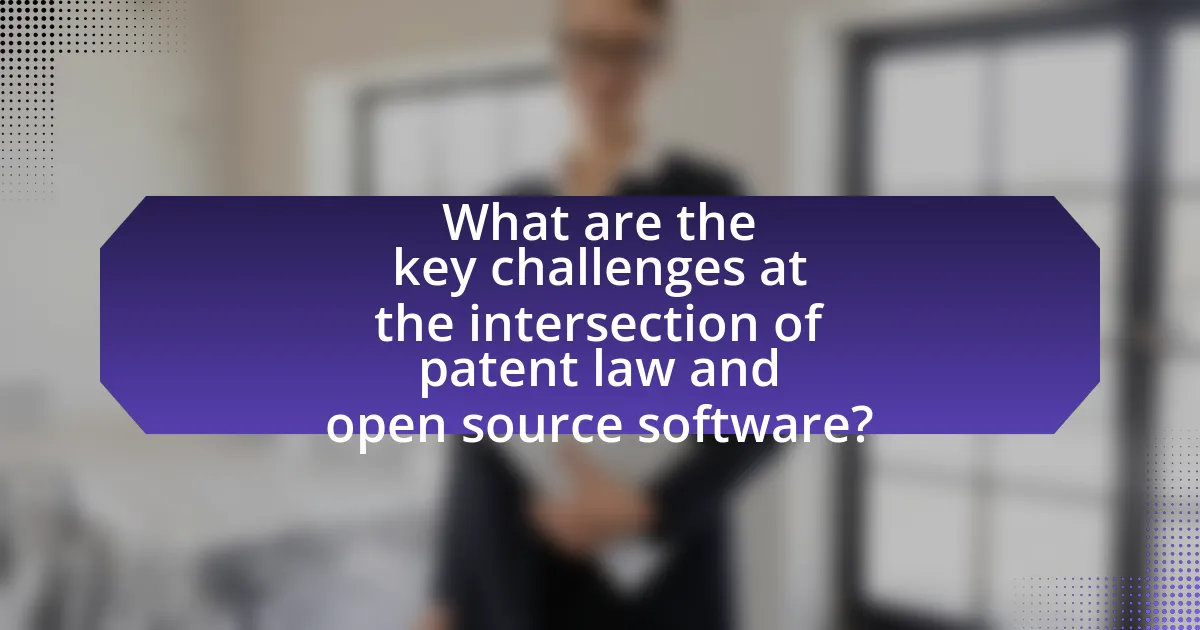
What are the key challenges at the intersection of patent law and open source software?
The key challenges at the intersection of patent law and open source software include the risk of patent infringement, the ambiguity of patent rights in open source licenses, and the potential for patent trolls to exploit open source projects. Patent infringement occurs when open source software inadvertently uses patented technology, leading to legal disputes. The ambiguity arises because open source licenses often do not clearly define the scope of patent rights granted to users, creating uncertainty about what is permissible. Additionally, patent trolls, or entities that enforce patent rights without producing products, can target open source projects, threatening their sustainability and innovation. These challenges complicate the development and distribution of open source software, as developers must navigate a complex legal landscape while fostering collaboration and innovation.
What legal disputes arise from this intersection?
Legal disputes arising from the intersection of patent law and open source software primarily involve patent infringement claims against open source projects. These disputes often occur when proprietary software companies assert that open source software violates their patents, leading to litigation or licensing negotiations. For instance, the case of Oracle vs. Google highlighted the complexities of using patented technologies within open source frameworks, where Oracle claimed that Google’s use of Java APIs in Android infringed on its patents. Such disputes can create uncertainty for developers and users of open source software, as they navigate the risks of potential legal action while promoting collaborative innovation.
How do patent trolls affect open source projects?
Patent trolls negatively impact open source projects by threatening developers with patent infringement lawsuits, which can lead to financial strain and project abandonment. These entities, often holding patents without the intention of producing products, exploit the open source community’s reliance on shared code. For instance, a study by the Electronic Frontier Foundation found that patent litigation can deter innovation, as developers may choose to avoid certain technologies altogether to evade potential legal issues. This creates a chilling effect on collaboration and the growth of open source software, ultimately stifling technological advancement.
What are the implications of patent infringement claims on open source software?
Patent infringement claims can significantly impact open source software by creating legal risks and uncertainties for developers and users. These claims may lead to costly litigation, which can deter contributions to open source projects and discourage adoption by businesses concerned about potential legal repercussions. For instance, the 2018 case of Oracle v. Google highlighted how patent disputes can arise in the context of open source, affecting the development and distribution of software. Additionally, patent claims can force open source projects to alter their licensing or codebase to avoid infringement, potentially compromising the principles of openness and collaboration that underpin the open source movement.
How do different jurisdictions handle patent law and open source software?
Different jurisdictions handle patent law and open source software in varied ways, reflecting their legal frameworks and policy priorities. In the United States, patent law allows for the patenting of software, including open source software, which can lead to conflicts when open source licenses require sharing modifications. The U.S. courts have upheld the validity of software patents, impacting how open source developers navigate patent risks. In contrast, the European Union has a more cautious approach, where software as such is generally not patentable, although technical implementations can be patented. This distinction influences how open source software is developed and shared in Europe, as developers face fewer patent-related restrictions. Additionally, countries like India have adopted a hybrid approach, where software can be patented but with specific limitations, promoting innovation while protecting open source principles. These differences highlight the complex relationship between patent law and open source software across jurisdictions, affecting developers’ strategies and the overall software ecosystem.
What are the variations in patent law across countries?
Patent law varies significantly across countries in terms of patentability criteria, duration of protection, enforcement mechanisms, and exceptions. For instance, the United States allows for the patenting of software and business methods, while many European countries impose stricter requirements, often excluding certain software-related inventions from patentability. Additionally, the duration of patent protection typically lasts 20 years from the filing date in most jurisdictions, but enforcement practices can differ, with some countries having more robust legal frameworks for patent enforcement than others. Countries like Japan and South Korea have specific provisions that may favor local industries, impacting how patents are granted and enforced. These variations can influence the development and use of open source software, as differing patent laws may affect the ability to innovate and share technology across borders.
How do these variations impact global open source projects?
Variations in patent law significantly impact global open source projects by influencing the legal landscape in which these projects operate. For instance, differing patent laws across countries can create uncertainty for developers regarding the use of patented technologies, potentially leading to reduced collaboration and innovation. A study by the Open Source Initiative indicates that countries with more restrictive patent laws often see a decline in open source contributions, as developers fear litigation or the inability to monetize their work. This legal variability can hinder the growth and sustainability of open source projects, as contributors may choose to avoid jurisdictions with stringent patent protections that conflict with open source principles.
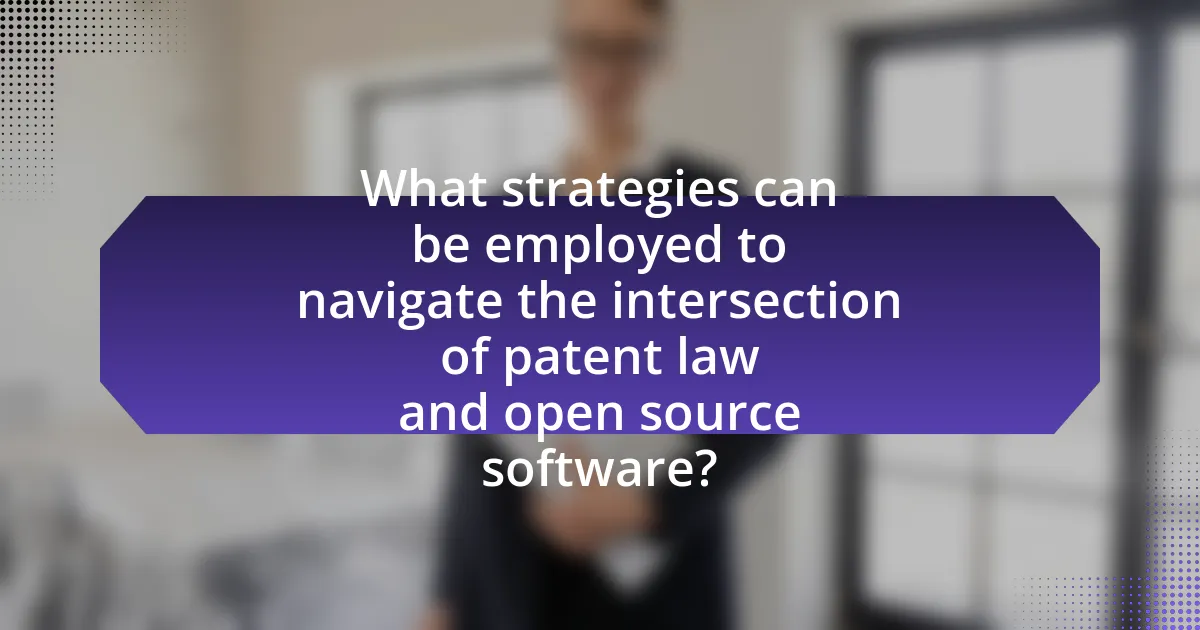
What strategies can be employed to navigate the intersection of patent law and open source software?
To navigate the intersection of patent law and open source software, developers can employ strategies such as using permissive licenses, conducting thorough patent searches, and engaging in defensive patenting. Permissive licenses, like the MIT or Apache licenses, allow users to modify and distribute software while minimizing patent risks. Conducting thorough patent searches helps identify existing patents that may affect the software, reducing the likelihood of infringement. Engaging in defensive patenting, where developers file patents on their innovations, can deter litigation from patent holders and protect their open source contributions. These strategies are supported by the increasing trend of open source projects adopting licenses that explicitly address patent rights, such as the Apache License 2.0, which includes a grant of patent rights to users.
How can developers ensure compliance with patent law while using open source software?
Developers can ensure compliance with patent law while using open source software by conducting thorough patent searches and reviewing the licensing terms of the software. Patent searches help identify any existing patents that may cover the software’s functionality, reducing the risk of infringement. Additionally, understanding the specific open source license, such as the GNU General Public License or the Apache License, is crucial, as these licenses often include clauses related to patent rights and obligations. For instance, the Apache License explicitly grants users a license to any patents held by contributors, which can provide a layer of protection against patent claims. By combining diligent patent research with a clear understanding of open source licenses, developers can navigate the complexities of patent law effectively.
What best practices should developers follow when integrating open source components?
Developers should adhere to several best practices when integrating open source components, including thorough evaluation of licenses, maintaining documentation, and ensuring security compliance. Evaluating licenses is crucial as it helps developers understand the legal implications and obligations associated with the open source components they intend to use. For instance, components under the GNU General Public License require that derivative works also be open source, which can affect project distribution. Maintaining documentation of all integrated components, including their versions and licenses, is essential for future reference and compliance audits. Additionally, ensuring security compliance involves regularly updating components to mitigate vulnerabilities, as evidenced by the 2021 GitHub Octoverse report, which highlighted that 77% of developers prioritize security in their open source usage. By following these practices, developers can effectively manage legal and security risks associated with open source software integration.
How can organizations create policies to manage patent risks in open source software?
Organizations can create policies to manage patent risks in open source software by implementing a comprehensive risk assessment framework that identifies potential patent infringement issues. This framework should include regular audits of open source components used in their software, ensuring compliance with licensing terms, and maintaining an updated inventory of all open source software utilized. Additionally, organizations should establish clear guidelines for contributions to open source projects, including patent licensing agreements that clarify ownership and rights.
To support these policies, organizations can leverage tools such as software composition analysis (SCA) tools that help detect and manage open source components and their associated licenses. Furthermore, training employees on patent law and open source licensing can enhance awareness and compliance. According to a 2021 study by the Open Source Initiative, organizations that actively manage their open source usage reduce the risk of patent litigation by up to 30%.
What resources are available for understanding patent law in the context of open source software?
Resources for understanding patent law in the context of open source software include legal textbooks, online courses, and specialized websites. Notable textbooks such as “Patent Law and Policy: Cases and Materials” by Herbert F. Schwartz provide foundational knowledge. Online platforms like Coursera and edX offer courses on intellectual property that cover patent law specifics. Websites such as the Electronic Frontier Foundation and the Open Source Initiative provide articles and guides that address the implications of patent law on open source projects. These resources collectively offer comprehensive insights into navigating patent law within the open source software landscape.
Where can developers find legal guidance on patent issues related to open source?
Developers can find legal guidance on patent issues related to open source through organizations such as the Open Source Initiative and the Electronic Frontier Foundation. These organizations provide resources, legal advice, and educational materials specifically addressing the intersection of patent law and open source software. Additionally, legal firms specializing in intellectual property law often publish articles and offer consultations on patent-related concerns in open source projects, ensuring developers have access to expert advice tailored to their needs.
What organizations support open source developers in navigating patent law?
Organizations that support open source developers in navigating patent law include the Open Source Initiative (OSI), the Free Software Foundation (FSF), and the Electronic Frontier Foundation (EFF). These organizations provide resources, legal guidance, and advocacy to help developers understand patent implications in open source projects. For instance, the EFF offers legal support and educational materials on patent issues, while the OSI promotes the use of open source licenses that mitigate patent risks.
What are the best practices for protecting innovations in open source software?
The best practices for protecting innovations in open source software include using licenses that clearly define usage rights, maintaining comprehensive documentation, and engaging in community collaboration. Open source licenses, such as the GNU General Public License (GPL) or the MIT License, provide legal frameworks that protect the original creator’s rights while allowing others to use, modify, and distribute the software. Comprehensive documentation ensures that the innovation is well understood and can be properly attributed, which is crucial for maintaining intellectual property rights. Additionally, engaging with the community fosters collaboration and can lead to collective protection efforts, as seen in projects like the Open Source Initiative, which advocates for open source principles and provides resources for developers. These practices help safeguard innovations while promoting a collaborative environment.
